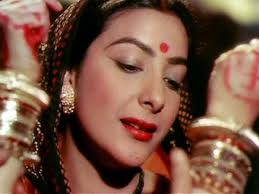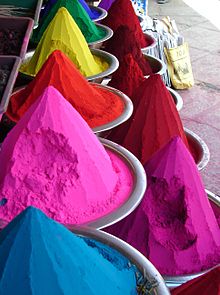
Kumkuma is a powder used for social and religious markings in India. It is made from turmeric or any other local materials. The turmeric is dried and powdered with a bit of slaked lime, which turns the rich yellow powder into a red color.
In India, it is known by many names including kuṅkumam (Sanskrit कुङ्कुमम्), kumkuma (Telugu కుంకుమ), kunku (Marathi कुंकू), kumkum (Bengali কুমকুম, Hindi कुमकुम), kunkuma (Kannada ಕುಂಕುಮ), (Tamil குங்குமம்), and kungkumam (Malayalam കുങ്കുമം).
Contents
Application
Kumkuma is most often applied by Indians to the forehead. The reason has to do with the ancient Indian belief that "the human body is divided into seven vortices of energy, called chakras, beginning at the base of the spine and ending at the top of the head. The sixth chakra, also known as the third eye, is centered in the forehead directly between the eyebrows and is believed to be the channel through which humankind opens spiritually to the Divine".
Thus, the kumkuma is placed where Indians believe the body to be the most holy.
Common forehead marks
- Saivites: Followers of Siva usually apply three white horizontal lines with a dot of kumkuma at the center.
- Vaisnavas: Followers of Vishnu make use of "white clay to apply two vertical lines joined at the base and intersected by a bright red streak." Many times the clay is applied in a U-shape.
- Swaminarayana: Followers of the Swaminarayan faith apply kumkuma at the center of the forehead and between a U-shaped tilaka. The tilaka is normally yellow and made from sandalwood.
- Chandrakor: Many Maharashtrians - men, women, and children alike - wear it traditionally in the shape of crescent moon.
Significance
In the Vaishnava tradition, the "white lines represent the footprint of their God, while the red refers to his consort, Lakshmi". The Swaminarayana tradition holds that the tilaka (yellow U-shaped mark) "is a symbol of the lotus feet of Paramatma," and the kumkuma "represents the bhakta" (devotee).[2] In both of these traditions, the forehead mark serves as a reminder that a devotee of God should always remain as a servant at the feet of God.
The 'color' of the womb is yellow and is symbolically represented by turmeric. The blood stains on the womb is represented by kumkuma. It is believed that the combination of turmeric and kumkuma represents prosperity.[citation needed]
Kumkuma and women
When a girl or a married woman visits a house, it is a sign of respect (in case of an elderly lady) or blessings (in case of a girl) to offer kumkuma to them when they leave. However, it is not offered to widows.
When visiting a temple, married women from southern India usually dip their ring finger in yellow turmeric powder and apply a dot on their neck. Men, women, girls, and boys apply a dot on their forehead of red turmeric powder, when visiting a temple or during a pooja. Kumkuma at temples is found in heaps. People dip their thumb into the heap and apply it on the forehead or between the eyebrows.
In most of India, married women apply red kumkuma to the parting of their hair above their forehead every day as a symbol of marriage. This is called vermilion, or in Hindi, sindoor. In southern India, many unmarried girls wear a bindi every day unlike northern India where it is only worn as a symbol of marriage.
Making kumkuma
Kumkum may be made from synthetic pigment and there are toxicity concerns with this, especially because kumkum is repeatedly applied directly to the skin.[citation needed] Kumkum is said to be made from turmeric by treating with alkali.
Other uses
Kumkuma is also widely used for worshiping the Hindu goddesses, especially Shakti and Lakshmi, and a kumkuma powder is thrown (along with other mixtures) into the air during Holi (the Festival of Colours), a popular Hindu spring festival.
See also
- Haldi Kumkum
- Bindi (decoration)
- Tilaka
- List of materials used in India
Anushka Sharma Contact Details

Lara Dutta Contact Details

Mandakini Contact Details

Shazahn Padamsee Contact Details

Radhika Apte Contact Details
Nargis Dutt Contact Details

Ritika Singh Contact Details
Pinky Parikh Contact Details
Surabhi Balasaraswati Contact Details
Alka Anjali Contact Details
Kirti Doshi Contact Details
Wamiqa Gabbi Contact Details
Shabana Sadique Contact Details
Sheeba Shabnam Contact Details
Moehra Contact Details
Asha Patil Contact Details
Mahek Chahal Contact Details
Sneha Laxmeshwar Contact Details
Supriya Pathare Contact Details
Neela Chopra Contact Details
Pallavi Sreshta Contact Details
Kumkum Pics images photo, address and all type of information about Kumkum likes height, weight, age, size, life style, interest ,contact number, mobile or phone, latest info all these thing you can get here as PCDS User You have to just to Register and do login with name of actress and we will send you the address and all related pic of Kumkum with their biography, Education, color etc to you. Note: Only if it's publicaly available and verified
Below are the example data its only for demo
Kumkum Life Style :: High ClassKumkum likes :: Natural
Kumkum Height :: 135 cm
Kumkum Weight :: 44 kG
Kumkum Whatsapp Mobile no :: Request For Number
Kumkum Contact address :: Request For Address
Kumkum Contact email id :: Request For email id
